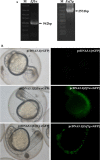Generation of Cas9 transgenic zebrafish and their application in establishing an ERV-deficient animal model
- PMID: 30244429
- PMCID: PMC6223727
- DOI: 10.1007/s10529-018-2605-5
Generation of Cas9 transgenic zebrafish and their application in establishing an ERV-deficient animal model
Abstract
Objectives: To investigate the effect of endogenous Cas9 on genome editing efficiency in transgenic zebrafish.
Results: Here we have constructed a transgenic zebrafish strain that can be screened by pigment deficiency. Compared with the traditional CRISPR injection method, the transgenic zebrafish can improve the efficiency of genome editing significantly. At the same time, we first observed that the phenotype of vertebral malformation in early embryonic development of zebrafish after ZFERV knockout.
Conclusions: The transgenic zebrafish with expressed Cas9, is more efficient in genome editing. And the results of ZFERV knockout indicated that ERV may affect the vertebral development by Notch1/Delta D signal pathway.
Keywords: CRISPR/Cas9; Embryonic development; Genomic editing; Spinal abnormality; Zebrafish.
Conflict of interest statement
The authors declare that they have no conflicts of interest with the contents of this article.
Figures





Similar articles
-
CRISPR/Cas9-based genome engineering of zebrafish using a seamless integration strategy.FASEB J. 2018 Sep;32(9):5132-5142. doi: 10.1096/fj.201800077RR. Epub 2018 May 29. FASEB J. 2018. PMID: 29812974
-
Exogenous gene integration mediated by genome editing technologies in zebrafish.Bioengineered. 2017 May 4;8(3):287-295. doi: 10.1080/21655979.2017.1300727. Epub 2017 Mar 8. Bioengineered. 2017. PMID: 28272984 Free PMC article. Review.
-
Efficient CRISPR/Cas9 genome editing with low off-target effects in zebrafish.Development. 2013 Dec;140(24):4982-7. doi: 10.1242/dev.099085. Epub 2013 Nov 20. Development. 2013. PMID: 24257628
-
Multiplex conditional mutagenesis in zebrafish using the CRISPR/Cas system.Methods Cell Biol. 2016;135:3-17. doi: 10.1016/bs.mcb.2016.04.018. Epub 2016 May 30. Methods Cell Biol. 2016. PMID: 27443918
-
A Transgenic Core Facility's Experience in Genome Editing Revolution.Adv Exp Med Biol. 2017;1016:75-90. doi: 10.1007/978-3-319-63904-8_4. Adv Exp Med Biol. 2017. PMID: 29130154 Review.
Cited by
-
Human Endogenous Retroviruses as Gene Expression Regulators: Insights from Animal Models into Human Diseases.Mol Cells. 2021 Dec 31;44(12):861-878. doi: 10.14348/molcells.2021.5016. Mol Cells. 2021. PMID: 34963103 Free PMC article. Review.
-
Zebrafish as a preclinical model for diabetes mellitus and its complications: From monogenic to gestational diabetes and beyond.World J Diabetes. 2025 May 15;16(5):100574. doi: 10.4239/wjd.v16.i5.100574. World J Diabetes. 2025. PMID: 40487612 Free PMC article. Review.
-
Research Progress on the Construction and Application of a Diabetic Zebrafish Model.Int J Mol Sci. 2023 Mar 8;24(6):5195. doi: 10.3390/ijms24065195. Int J Mol Sci. 2023. PMID: 36982274 Free PMC article. Review.
-
Genetically engineered zebrafish as models of skeletal development and regeneration.Bone. 2023 Feb;167:116611. doi: 10.1016/j.bone.2022.116611. Epub 2022 Nov 14. Bone. 2023. PMID: 36395960 Free PMC article. Review.
-
Modeling Neuronal Diseases in Zebrafish in the Era of CRISPR.Curr Neuropharmacol. 2020;18(2):136-152. doi: 10.2174/1570159X17666191001145550. Curr Neuropharmacol. 2020. PMID: 31573887 Free PMC article. Review.
References
MeSH terms
Grants and funding
LinkOut - more resources
Full Text Sources
Other Literature Sources
Molecular Biology Databases
Research Materials

